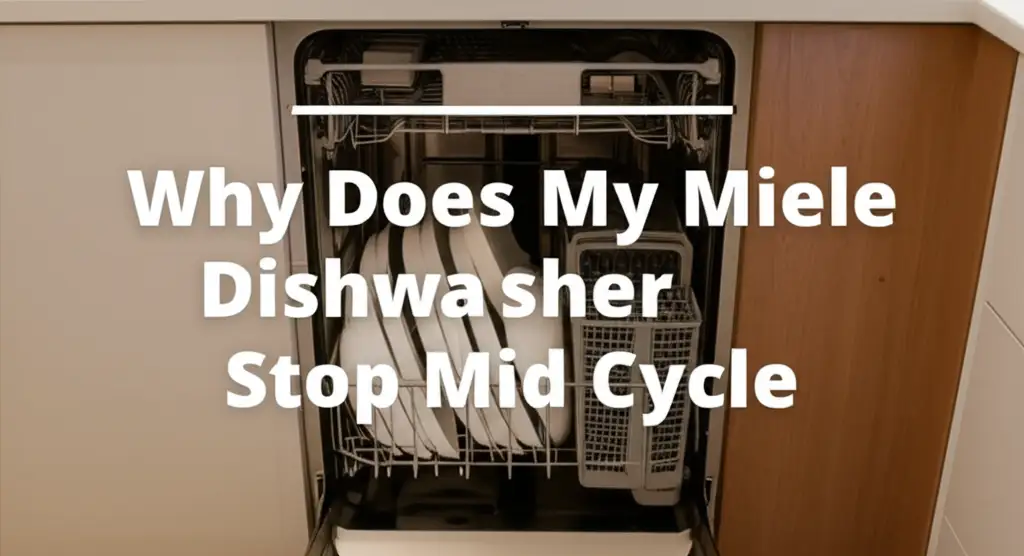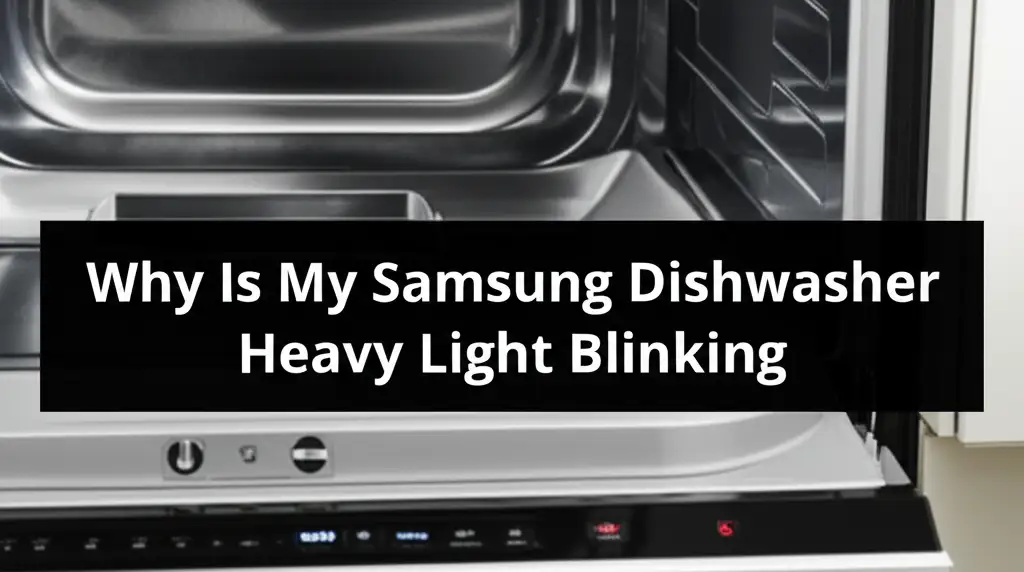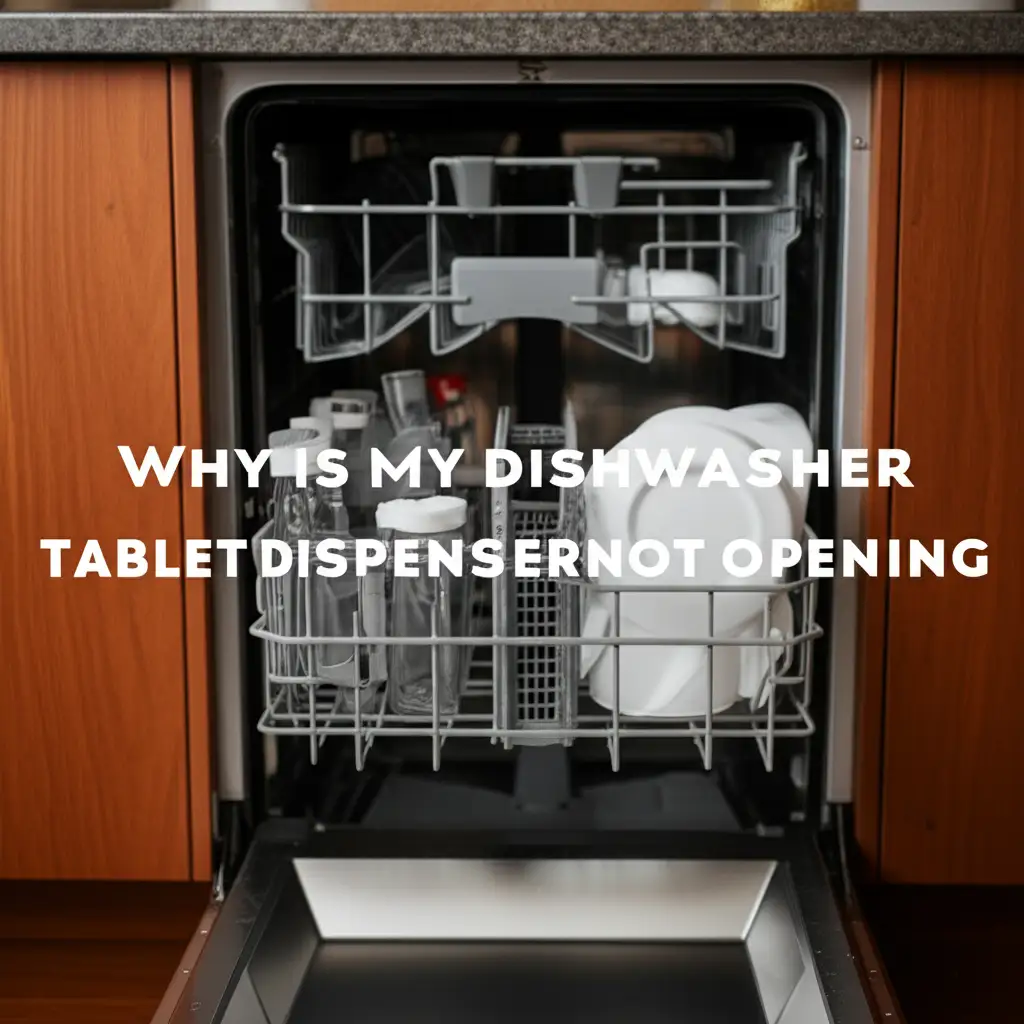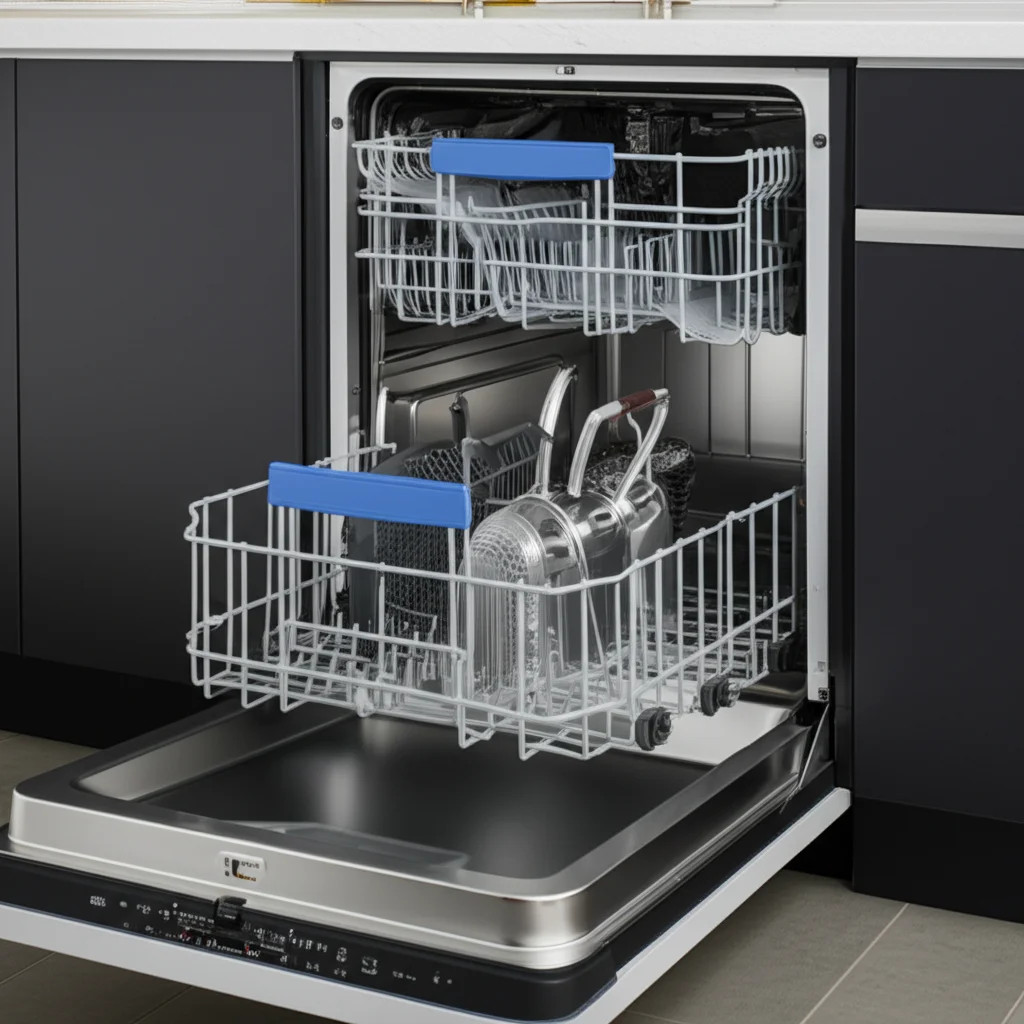· Todd Martin · Home Appliances, Dishwasher Repair, Miele Appliances · 20 min read
Why Does My Miele Dishwasher Stop Mid Cycle

Miele Dishwasher Halts Mid-Cycle: Causes & Fixes
Picture this: Your Miele dishwasher hums along, cleaning dishes, then suddenly, silence. It stops mid-cycle, leaving you with unfinished dishes and a puzzling problem. This interruption can be incredibly frustrating, especially with a premium appliance like a Miele. I understand the inconvenience this creates in your daily routine. You expect seamless operation from your kitchen essentials.
Many factors can cause your Miele dishwasher to stop mid-cycle. These issues range from simple user errors to more complex mechanical or electrical faults. We will explore common culprits like inadequate water supply, drainage blockages, faulty sensors, or a problematic door latch. This article provides practical troubleshooting steps. I will help you diagnose the problem and offer solutions to get your Miele dishwasher running smoothly again.
Takeaway
- Check Water Supply: Ensure water pressure is sufficient and the inlet valve is clear.
- Inspect Drainage System: Clean filters, check the drain hose for kinks, and verify drain pump function.
- Examine Door Latch: A secure door is vital; inspect the latch and interlock switch.
- Address Sensor Issues: Faulty temperature, turbidity, or water level sensors can cause interruptions.
- Review Electrical & Control Board: Look for power disruptions or component failures.
- Consider User Error: Proper loading, detergent, and cycle selection impact performance.
A Miele dishwasher stopping mid-cycle typically indicates a detected fault within the system, such as insufficient water intake, drainage issues, an open door, or a sensor detecting abnormal conditions like incorrect water temperature or turbidity. Power interruptions or user-related errors can also cause immediate cycle halts.
Understanding Water Supply Problems for Miele Dishwashers
One of the most frequent reasons your Miele dishwasher stops mid-cycle involves its water supply. The machine needs a steady and adequate flow of water to complete its washing phases. If the dishwasher does not receive enough water, or if water pressure is too low, it will often pause or stop the cycle as a safety measure. This prevents damage to internal components and ensures proper cleaning. I always check the water supply first when troubleshooting.
Low Water Pressure & Inlet Valve Issues
Your home’s water pressure might be insufficient for the dishwasher. This can happen if other water-consuming appliances, like showers or washing machines, run simultaneously. Miele dishwashers are sensitive to water pressure fluctuations. They need a minimum pressure to operate correctly. Check if the water shut-off valve for the dishwasher is fully open. Sometimes, it might be partially closed, restricting flow.
A faulty water inlet valve is another common culprit. This valve controls the flow of water into the dishwasher. If it is clogged, defective, or not opening fully, the machine cannot fill properly. The dishwasher’s control system will detect this lack of water and stop the cycle. You might hear a buzzing sound from the valve area when it tries to open but fails. I recommend checking the water connection for kinks or blockages too.
Clogged Water Inlet Filter
Miele dishwashers often have a small filter at the water inlet connection point. This filter traps sediment and debris from your home’s water supply. Over time, this filter can become clogged, reducing water flow into the appliance. A partially blocked filter will restrict water entry. This leads to the dishwasher stopping mid-cycle because it cannot reach the required water level. Regular maintenance includes checking and cleaning this filter.
You can usually find this filter where the water supply hose connects to the dishwasher. Turn off the water supply before disconnecting the hose to inspect and clean the filter. A clean filter ensures a smooth and unrestricted flow of water into your Miele dishwasher. This simple check can often resolve unexpected cycle interruptions. Addressing water supply issues promptly helps your Miele dishwasher perform efficiently. For similar issues with other brands, you can find helpful information on why your Frigidaire dishwasher might stop mid-cycle. Knowing how water supply affects operation is key for any appliance. Another helpful resource might be on why your LG dishwasher keeps stopping mid-cycle, as water issues are often universal.
Addressing Miele Dishwasher Drainage System Failures
Just as water needs to get into your Miele dishwasher, it also needs to get out efficiently. Drainage problems are a very common cause for a dishwasher to stop mid-cycle. If the machine cannot drain the dirty water, it will halt the cycle. This prevents dirty water from overflowing or recirculating. I always consider the drainage system when troubleshooting Miele dishwasher issues.
Clogged Drain Filter & Sump Area
Miele dishwashers have sophisticated filtration systems to prevent food particles from clogging the drain pump. These filters are usually located at the bottom of the wash tub. Over time, food debris, grease, and other residue can accumulate in these filters. A heavily clogged filter will restrict water from draining properly. This leads to standing water in the tub and a cycle interruption.
Regularly cleaning the dishwasher’s filters is crucial for optimal performance. You can usually remove, rinse, and clean these filters by hand. Pay attention to the sump area underneath the filters as well. Small debris can collect here and impede drainage. A clear filter system allows for efficient water removal.
Blocked Drain Hose or Air Gap
The drain hose carries wastewater from the dishwasher to your home’s drainage system. This hose can become kinked, bent, or obstructed internally. Food particles or grease can build up inside the hose over time. If the hose runs under the sink, check for any physical obstructions or bends. A kinked hose restricts water flow significantly.
Some installations include an air gap on the sink, which prevents drain water from flowing back into the dishwasher. This air gap can also become clogged with debris. If you have an air gap, inspect it for blockages. Clearing any blockages in the drain hose or air gap allows the dishwasher to expel water properly. A blocked drain can cause issues similar to those described for a GE dishwasher having standing water after the cycle.
Faulty Drain Pump
If the filters and hoses are clear, the issue might be with the drain pump itself. The drain pump is responsible for forcibly expelling water from the dishwasher. A faulty or obstructed drain pump cannot remove water, causing the cycle to stop. You might hear a buzzing or humming sound if the pump is trying to work but cannot.
Sometimes, small foreign objects like broken glass or fruit pits can get into the pump impeller, jamming it. In other cases, the pump motor might be failing. Checking the drain pump often requires accessing the dishwasher’s underside. This might need a professional. Ensuring a clear drainage path is vital for any dishwasher. A good understanding of the drain system can help prevent frustrating interruptions.
Miele Dishwasher Door Latch and Interlock Issues
Your Miele dishwasher relies on a securely closed door to operate safely and effectively. The door latch mechanism is not just for keeping the door shut; it also contains a safety switch, known as the door interlock switch. If this switch does not register that the door is fully closed and latched, the dishwasher will not start or will stop mid-cycle. This is a crucial safety feature designed to prevent leaks and accidents. I often find that this simple component is overlooked.
Misaligned or Damaged Latch
Over time, the dishwasher door or the latch mechanism itself can become misaligned. Frequent opening and closing, or even leaning on the door, can cause it to shift slightly. If the door is not perfectly aligned, the latch might not engage fully with the strike plate on the dishwasher’s frame. Even a millimeter of misalignment can prevent the interlock switch from activating. I recommend checking the door for any signs of sagging or looseness.
A damaged latch is another possibility. The plastic or metal components of the latch can wear out, break, or become deformed. If the latch is physically broken, it cannot hold the door securely, and the dishwasher will detect an open door. You might notice the door feels loose even when you try to close it. Visually inspect the latch for any cracks, chips, or bent parts. Sometimes, a simple adjustment can fix misalignment. However, a damaged latch requires replacement.
Faulty Door Switch Sensor
The door interlock switch is the electronic component that tells the dishwasher’s control board whether the door is closed. This switch is typically located near the latch assembly. If the switch itself becomes faulty, it might not send the correct signal, even if the door is perfectly closed and latched. The dishwasher’s brain believes the door is open, so it stops the cycle. This is a common cause for mid-cycle interruptions.
Testing the door switch usually requires a multimeter and some technical knowledge. If you suspect the switch is faulty, it is often best to consult the service manual or a professional. A malfunctioning door switch can lead to mysterious stoppages. This is a similar issue to why a KitchenAid dishwasher starts and stops – the door latch is a common culprit. Ensuring the door is securely closed and the switch works properly is fundamental for your Miele dishwasher’s operation.
Sensor Malfunctions in Your Miele Dishwasher
Miele dishwashers are equipped with advanced sensors that monitor various conditions during a wash cycle. These sensors provide critical data to the control board, ensuring optimal performance and detecting potential issues. If any of these sensors malfunction or provide incorrect readings, the dishwasher’s control system might interpret this as a problem and stop the cycle. I have seen many instances where a seemingly minor sensor issue leads to a complete halt.
NTC Thermistor (Temperature Sensor) Errors
The NTC thermistor, or temperature sensor, monitors the water temperature inside the wash tub. Proper water temperature is crucial for effective cleaning and sanitation. If the thermistor is faulty, it might send incorrect temperature readings to the control board. For example, it might report that the water is too cold when it is actually hot, or vice-versa.
When the control board receives a reading indicating an unsafe or incorrect temperature, it can halt the cycle. This prevents damage to dishes or ensures proper wash conditions. A faulty thermistor can cause the heating element to work improperly or not at all. This leads to the cycle stopping due to temperature discrepancies. This is a critical component for the wash process.
Turbidity Sensor (Water Cleanliness) Issues
Miele dishwashers often feature a turbidity sensor. This sensor assesses the dirtiness of the wash water. It helps the dishwasher determine how much water to use and how long to wash for optimal results. If the turbidity sensor becomes dirty or malfunctions, it might give inaccurate readings. For example, it might constantly detect very dirty water, even if the dishes are pre-rinsed.
An incorrect reading from the turbidity sensor can confuse the control board. The dishwasher might then try to extend the cycle unnecessarily or, conversely, stop prematurely if it incorrectly senses clean water too early. Sometimes, a simple cleaning of the sensor can resolve the issue. Excessive food particles or detergent residue can obscure the sensor’s view.
Water Level Sensor (Flow Meter) Problems
The water level sensor, or flow meter, measures the amount of water entering the dishwasher. It ensures the dishwasher fills to the correct level for each stage of the cycle. If this sensor fails, it might inaccurately report water levels to the control board. This can lead to the dishwasher under-filling or over-filling.
If the dishwasher detects an incorrect water level, it will stop the cycle to prevent flooding or to ensure adequate water for washing. A malfunctioning water level sensor can be tricky to diagnose without specialized tools. These sensors are vital for the precise operation of your Miele. Any LG dishwasher beeping during the cycle can often point to sensor issues as well, indicating a broader appliance concern. Proper sensor function is essential for smooth and error-free operation.
Electrical and Control Board Troubles with Miele Units
Beyond mechanical and sensor issues, electrical problems and faults with the control board can cause your Miele dishwasher to stop mid-cycle. These issues often require a more technical approach to diagnose and fix. Miele appliances are known for their sophisticated electronics. However, even the most robust systems can encounter problems. I always advise caution when dealing with electrical components.
Power Supply Interruptions & Tripped Breakers
An obvious but often overlooked cause for a dishwasher stopping is a power supply interruption. This can be due to a brief power outage in your home or a tripped circuit breaker dedicated to the dishwasher. If the dishwasher loses power at any point during the cycle, it will, of course, stop. I recommend checking your home’s circuit breaker box first. Locate the breaker for the kitchen or the dishwasher specifically and see if it has tripped. Simply flipping it off and then back on can resolve the issue.
Sometimes, a loose connection at the wall outlet or the dishwasher’s power cord itself can cause intermittent power loss. Ensure the power cord is fully plugged into a functional outlet. Avoid using extension cords, as they can lead to voltage drops or overheating. An unstable power supply can confuse the control board and trigger a cycle halt.
Control Board or Thermal Fuse Malfunctions
The control board, often referred to as the “brain” of the dishwasher, manages all its functions. It receives signals from sensors and sends commands to components like the pump, motor, and heating element. If the control board malfunctions, it can send incorrect commands or fail to process information properly. This can lead to erratic behavior, including stopping mid-cycle without a clear reason. A faulty control board might need replacement, which is typically an expensive repair.
Another electrical component to consider is the thermal fuse. Many dishwashers have a thermal fuse as a safety device. It is designed to trip and cut power to the appliance if it detects overheating. This overheating could be due to a failing motor, a continuously running heating element, or other electrical issues. Once the thermal fuse trips, it will stop the dishwasher mid-cycle and often needs replacement. It’s important to address the underlying cause of overheating before replacing the fuse. General power issues, like Miele washing machine having no power, share similarities with dishwasher power problems. Also, a GE dishwasher that won’t start the wash cycle could point to control board or power supply issues. These electrical faults require careful diagnosis and often professional intervention.
Overloading, Detergent, and User Error for Miele Dishwashers
Sometimes, the reason your Miele dishwasher stops mid-cycle is not a mechanical failure but rather a user-related issue. Even the most advanced appliances rely on proper operation and maintenance from the user. Simple mistakes in loading, detergent use, or cycle selection can lead to unexpected interruptions. I’ve often found these human errors to be easily preventable.
Improper Loading and Spray Arm Obstruction
Overloading your dishwasher is a common mistake. Packing too many dishes, or placing them incorrectly, can block the spray arms. The spray arms need to rotate freely to distribute water and detergent effectively. If a large plate or a utensil prevents a spray arm from spinning, the dishwasher might detect an issue with water distribution or pressure. This can trigger a safety mechanism that halts the cycle.
I always recommend consulting your Miele dishwasher’s manual for optimal loading patterns. Ensure that dishes do not obstruct the spray arms’ rotation. Tall items should be placed carefully to avoid hitting the top spray arm. Proper loading ensures that water reaches all dishes and the cycle can complete without hindrance.
Incorrect Detergent Use or Too Much Rinse Aid
Using the wrong type or amount of detergent can cause problems. Miele dishwashers are designed to work with specific, high-quality dishwasher detergents. Using too much detergent, or using hand dish soap, can create excessive suds. Excessive suds can overflow the wash tub or trick the water level sensors. This causes the dishwasher to stop the cycle.
Similarly, an incorrect amount of rinse aid can lead to issues. While rinse aid helps with drying, using too much can sometimes cause excessive foaming, which again, can confuse the dishwasher’s sensors. Miele dishwashers are very efficient and require precise amounts of detergent and rinse aid. For specific guidance, you might find it useful to read about why your Miele dishwasher uses so much rinse aid, as it’s directly related to user settings. Always follow the manufacturer’s recommendations for detergent and rinse aid dosage.
Cycle Selection Errors
Sometimes, the cycle stopping mid-way might be due to an incorrect or unintended cycle selection. For example, if you accidentally select a “Delay Start” option, the dishwasher will appear to stop after starting briefly, only to resume later. Or, if a specific cycle requires certain conditions that are not met (e.g., hot water supply for a high-temperature wash), it might pause or stop.
Always double-check the selected wash program before starting the dishwasher. Ensure it matches the type of load and your desired cleaning intensity. Familiarize yourself with your Miele’s various cycle options and their specific requirements. Understanding user errors can save you time and money on unnecessary repairs. It is often the simplest fix.
When to Call for Professional Miele Service
While many Miele dishwasher problems can be resolved with DIY troubleshooting, some issues are beyond the scope of a homeowner. Recognizing when to call a professional service technician is crucial. Attempting complex repairs without proper training and tools can lead to further damage, void your warranty, or pose safety risks. I recommend seeking expert help for certain situations to ensure your Miele dishwasher receives the best care.
Complex Component Failure
If you have systematically gone through all the common troubleshooting steps—checking water supply, drainage, door latch, and basic user errors—and your Miele dishwasher still stops mid-cycle, the problem likely lies with a complex internal component. This could include:
- Motor or Circulation Pump Failure: These components are essential for spraying water and moving it through the system. A failing motor might make unusual noises or stop working entirely. Replacing these parts requires dismantling the appliance and specialized knowledge.
- Heating Element Issues: If the dishwasher cannot heat water to the correct temperature, it might stop. Testing and replacing a heating element involves electrical work and understanding the appliance’s internal layout.
- Main Control Board Replacement: As discussed earlier, a faulty control board is the brain of your dishwasher. If it’s malfunctioning, it sends incorrect signals or fails to send any at all. Replacing it is a precise task that requires specific Miele parts and programming, often specific to the model.
- Advanced Sensor Malfunctions: While you can sometimes clean a sensor, a truly faulty one needs replacement. Diagnosing which sensor is failing requires technical diagnostic tools.
These repairs are intricate and can involve high voltage. A professional technician has the training, tools, and access to genuine Miele parts to perform these replacements safely and effectively. They can ensure the repair is done correctly, preserving the longevity of your premium appliance.
Error Code Interpretation
Miele dishwashers are designed to display error codes when they detect a problem. These codes are invaluable diagnostic tools. When your dishwasher stops mid-cycle and displays an alphanumeric code on its screen, this code points to a specific issue. While your user manual might provide some basic interpretations, sometimes the codes can be ambiguous or point to underlying issues that are not immediately obvious.
A Miele service technician has access to detailed diagnostic charts and service manuals that provide in-depth explanations for each error code. They can use these codes to quickly pinpoint the exact component or system that is failing. For instance, an error code related to water intake might require checking the flow meter, while a drainage error might point to the drain pump. Without proper knowledge, interpreting these codes can be challenging. A professional can quickly read the code, understand its implications, and apply the correct fix, saving you time and preventing costly guesswork. They ensure your Miele dishwasher is back to its pristine condition efficiently.
FAQ Section
Why does my Miele dishwasher stop and beep?
A Miele dishwasher often stops and beeps to alert you of a detected error. This can be due to an open door, a water supply issue (like low pressure), a drainage problem (like a clogged filter), or a sensor malfunction (such as incorrect water temperature). The beeps often accompany a specific error code on the display, which helps pinpoint the problem.
How do I reset my Miele dishwasher when it stops?
To reset your Miele dishwasher, first try a simple power cycle. Unplug the dishwasher from the wall outlet or flip its dedicated circuit breaker off for 5-10 minutes, then restore power. This can clear minor electronic glitches. For specific models, pressing and holding the ‘Start/Stop’ or ‘Cancel’ button for a few seconds might also initiate a reset sequence.
Can a clogged filter stop a Miele dishwasher mid-cycle?
Yes, absolutely. A clogged filter is a very common reason for a Miele dishwasher to stop mid-cycle. If the main filter at the bottom of the wash tub is obstructed by food particles, it prevents water from draining properly. The dishwasher detects this drainage issue and halts the cycle to prevent overflow or poor washing performance.
What do Miele error codes mean when my dishwasher stops?
Miele error codes are diagnostic messages that appear on your dishwasher’s display when a problem occurs. Each code corresponds to a specific issue, such as F11 for a drain fault, F14 for a water intake error, or F78 for a circulation pump issue. Consulting your dishwasher’s user manual is the first step to understanding what a specific code means and potential troubleshooting steps.
Is it normal for a Miele dishwasher to pause during a cycle?
Yes, it is normal for a Miele dishwasher to pause briefly during certain parts of its cycle. These pauses typically occur during water changes, heating phases, or when the detergent dispenser opens. These are part of the normal operation designed for optimal cleaning and efficiency. However, a complete, prolonged stop with no intention to resume is an indication of a problem.
Why does my Miele dishwasher stop with water still inside?
If your Miele dishwasher stops mid-cycle with water remaining inside, it almost always indicates a drainage problem. The most common causes are a clogged drain filter, a kinked or obstructed drain hose, or a malfunctioning drain pump. The dishwasher cannot proceed with the next cycle phase until the dirty water is fully expelled.
Conclusion
Finding your Miele dishwasher stopping mid-cycle can be a real headache. I understand the frustration of interrupted routines and unfinished chores. We’ve explored many reasons why this might happen, from simple issues like low water pressure or a clogged filter to more complex problems involving sensors, the door latch, or the control board. Knowing these common culprits empowers you to diagnose and often fix the problem yourself.
I encourage you to systematically troubleshoot the potential causes we’ve discussed. Start with the easiest checks, such as verifying the water supply, inspecting the drainage system for blockages, and ensuring the door is securely latched. Don’t forget to consider user errors, like improper loading or detergent use, which are surprisingly common reasons for interruptions. Your Miele dishwasher is a precision appliance, and sometimes, a small adjustment makes a big difference. However, remember that some issues, especially those involving complex electrical components or persistent error codes, are best left to a certified Miele service technician. They possess the expertise and genuine parts needed to restore your Miele dishwasher to its optimal performance safely. By understanding these issues, you can keep your Miele dishwasher running efficiently, ensuring sparkling clean dishes for years to come.





